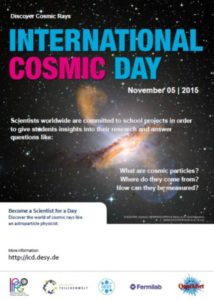
International Cosmic Day 2015
2 June 2015
November 5, 2015 DESY, Zeuthen
The International Cosmic Day enables students to get in contact with astroparticle physicists to get a first insight into their research, experimental methods and everyday work.
Some basic questions which will be adressed are:
What are cosmic particles?
Where do they come from?
How can they be measured?
The relatively young research field of astroparticle physics has been developing dynamically over the last years (some experiments are: ANTARES, Auger, BAIKAL, Fermi, HAWC, H.E.S.S., IceCube, MAGIC, Telescope Array, VERITAS ). It connects particle physics (describing the interactions of elementary particles) with astrophysics (describing up to the biggest structures in the universe) and with cosmology (studying the history of the universe). One of the very interesting topics in astroparticle physics is trying to understand the acceleration mechanisms of cosmic ray particles to very high energies, much higher than accelerators on Earth can reach.
The universe is a big place. Cosmic rays drift around and get energy boosts from multiple sources. Some particles attain enormous energies. When they strike the upper atmosphere, they initiate Extended Air Showers. These events create thousands of particles that simultaneously reach a small section of Earth’s surface. More energetic primaries affect larger sections of the surface.
On the International Cosmic Day we will focus on two questions which will be addressed by student experiments:
- Coincident air shower measurements: Can you find out how often nearby detectors simultaneously “light up” with cosmic rays? If they do, is it a randomness or a measurement of one of these showers?
- Zenith angle distribution of air shower particles: Can you find out if the number of air shower particles arriving from the horizon is the same as from above? If it is not, what could cause this effect?
The 4th International Cosmic Day on November 5, 2015 is organized by DESY, together with Netzwerk Teilchenwelt, IPPOG, QuarkNet and Fermilab and will enable students in many different countries around the world to get to do their own experiments at nearby universities, research institutions or even in their classrooms.
We invite students to:
- Perform their own cosmic particle experiment
- Analyze and present their data on a common website
- Compare their own results with the results of others
- Work like in an international research collaboration
- Get in contact with scientists and physics
All details can be found on the International Cosmic Day website.




